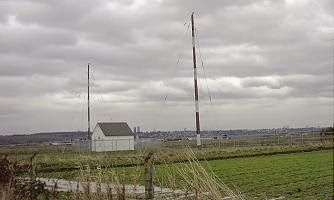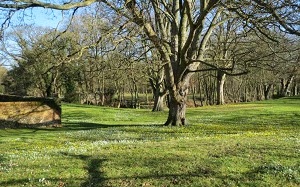 Monday brings two dx contacts
Monday brings two dx contacts
late afternoon it was time to go out with Julie who had a photography assignment that involved us going downtown (Toronto) for some shots she needed to get. It sure was cold out but soon we would be back to our warm home and just a little more radio time as she edited some photos. This time on 20m I heard HC5AI calling CQ from Ecuador and after some going back and forth he got my call and the contact was made.
Mike Weir, VE9KK, is a regular contributor to AmateurRadio.com and writes from New Brunswick, Canada. Contact him at ve9kk@hotmail.com.
 Hunting For NDB’s In CLE191
Hunting For NDB’s In CLE191
 |
| One CLE Target - 'VR' 266KHz / Vancouver Int'l Approach |
How time flies. For you low-frequency buffs, another challenge awaits. From CLE coordinator Brian Keyte (G3SIA) comes the following reminder:
"Our February Co-ordinated Listening Event will soon be here.
We'll be hunting for normal beacons in two contrasting frequency ranges.
One range also gives the possibility of hearing several amateur beacons.
As always, first-time CLE logs will be extra welcome.
Days: Friday 20 February - Monday 23 February
Times: Start and end at midday, your local time
Frequencies: 260.0 - 269.9 kHz
plus: 440.0 - 1740.0 kHz
Many of us should be able to hear beacons in both ranges, though Europe
only has a handful in the '260s'. From 440 onwards, Eastern Europe and
North Africa have several beacons and some regular UNIDs and some NDBs
can be found among Europe's Medium Wave Broadcast Stations.
Many of us are within range of some of the amateur beacons on frequencies around 470 kHz and 500 kHz - we'll be listening for ANYTHING OPERATING IN BEACON MODE, preferably with normal speed Morse.
(We ask operators who sometimes use QRSS, PSK, WSPR, etc., which need
software to receive them, to PLEASE CHOOSE THE SIMPLER MODE during
the CLE so that we shall all be able to receive and report them).
Send your CLE log to the List, preferably as a plain text email
and not in an attachment, with CLE191 at the start of its title.
Please show on EVERY LINE of your log:
# The full Date (or Day no.) and UTC (the day changes at 00:00 UTC).
# kHz (the beacon's nominal published frequency, if you know it)
# The Call Ident.
Other optional details, Location, Distance, etc., go LATER in the same
line (or in footnotes). Any extra details about UNIDs, especially strong
ones that may be near to you (maybe their approximate direction, etc.)
will help us to discover more about them. As always, please make your
log useful to old and new members alike by including your own location
and brief details of the equipment and aerial(s) you were using.
I will send an 'Any More Logs?' email at about 18:00 UTC on Tuesday
evening. From it you can check that your log has been found OK.
Do make sure that your log has arrived at the very latest by 09:00 UTC
on Wednesday 25 February.
I hope to finish making the combined results on that day."
These listening events serve several purposes. They:
- determine, worldwide, which beacons are actually in service and on-the-air so the online database can be kept up-to-date
- determine, worldwide, which beacons are out-of-service or have gone silent since the last CLE covering this range
- will indicate the state of propagation conditions at the various participant locations
- will give you an indication of how well your LF/MF receiving system is working
- give participants a fun yet challenging activity to keep their listening skills honed
Final details can be found at the NDB List website, and worldwide results, for every participant, will be posted there a few days after the event. If you are a member of the ndblist Group, results will also be e-mailed and posted there.
The very active Yahoo ndblist Group is a great place to learn more about the 'Art of NDB DXing' or to meet other listeners in your region. There is a lot of good information available there and new members are always very welcome.
If you are contemplating getting started on 630m, listening for NDBs is an excellent way to test out your receive capabilities as there are several NDBs located near this part of the spectrum.
You need not be an ndblist member to participate in the CLEs and all reports, no matter how small, are of much value to the organizers. 'First-time' logs are always VERY welcome!
Reports may be sent to the ndblist or e-mailed to either myself or CLE co- ordinator, Brian Keyte (G3SIA), whose address appears above.
Please...do give the CLE a try....then let us know what NDB's can be heard from your location! Your report can then be added to the worldwide database to help keep it up-to-date.
Steve McDonald, VE7SL, is a regular contributor to AmateurRadio.com and writes from British Columbia, Canada. Contact him at ve7sl@shaw.ca.
 Internet of Things (IoT) already here
Internet of Things (IoT) already here
This morning I received this email from KK4HSX saying that (certainly in the USA) Amazon is already selling wifi connected slow cookers called “Crock Pots”. Not sure if this is a stateside generic term.
It’s already here. Behold,the Crock Pot you can monitor and control with you phone.
http://www.amazon.com/Crock-
Pot-Wifi-Enabled-6-Quart- Cooker-SCCPWM600-V1/dp/ B00IPEO02C#
Roger Lapthorn, G3XBM, is a regular contributor to AmateurRadio.com and writes from Cambridge, England.
 Landwade
Landwade
Landwade was the site of my first “over the horizon” optical tests. The tests were successful, but predate my stroke by some time. I remember well being surprised at the reception when “on beam”.
We go here each year about this time for a delightful walk of about 1.5km calling at the small private church (locked these days). The church is surrounded by seas of snowdrops and aconites at this time of year. Landwade is very quiet at all times. It is in Suffolk but was in Cambridgeshire until 1994. It has been occupied since Roman times, but consists of a few farms, a hall and the odd cottage these days.
I have updated one of my other blogs.
See http://eachurches.blogspot.co.uk/ .
Roger Lapthorn, G3XBM, is a regular contributor to AmateurRadio.com and writes from Cambridge, England.
 KN0WCW – working the FISTS USA Club
KN0WCW – working the FISTS USA Club
I’m back up and running on HF after getting purchasing a very lightly used KX3 from Elecraft to replace my smoked radio! The radio arrived last Wednesday and I was back on the air that night. I’ve made a few casual contacts using various digital modes. I even worked K1N late in the week with 12 watts with CW on 20M. While not truly QRP, it does show that you don’t need a kilowatt to bust a pileup!
Also a notable contact was with KN0WCW/2 – that’s KNOW CW – the club call for the FISTS CW Club NA Chapter. Cody was the operator of the night from 2 land. I was slightly embarrassed even answering his call…my CW is rookie level at best, even with the great keyer on the KX3. I couldn’t get the /2 to come out right no matter what I did! Cody hung in there with me and we had a nice QSO. I didn’t keep him too long so he could log some more. Good job there Cody!
Michael Brown, KG9DW, is a regular contributor to AmateurRadio.com and writes from Illinois, USA. Contact him at michael@thefarmonline.com.
 A pity we don’t have an 8m (40MHz) band.
A pity we don’t have an 8m (40MHz) band.
An amateur band at 40MHz would be really useful as I suspect the F2 MUF has been in this region several times in the last few years. There are a very few beacons around 40MHz (UK and Denmark only I believe) but wouldn’t it be good to have even 100kHz around this frequency? Sadly it is very unlikely, but I would happily lose 100kHz at the top of 10m in exchange. It would also be a very useful Es band.
Somehow I can’t see this happening, more is the pity. The world of radio science would really benefit. This would have been so much more useful than 146-147MHz recently released to UK amateurs by NoV. I know a handful of UK amateurs are trying narrowband DTV but the 2m band is mainly Japanese “black boxes” and is mostly white noise in most areas.
Roger Lapthorn, G3XBM, is a regular contributor to AmateurRadio.com and writes from Cambridge, England.
 It’s a cold one out there!
It’s a cold one out there!
| Steam coming off the water down at the lake |
| The little motor in the antenna |
Mike Weir, VE9KK, is a regular contributor to AmateurRadio.com and writes from New Brunswick, Canada. Contact him at ve9kk@hotmail.com.















